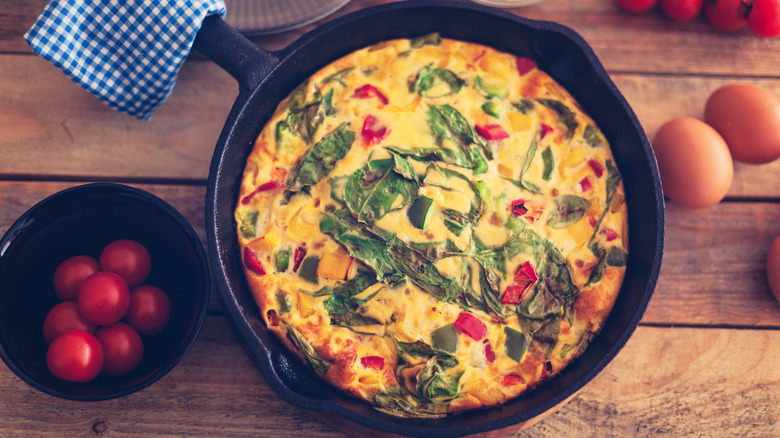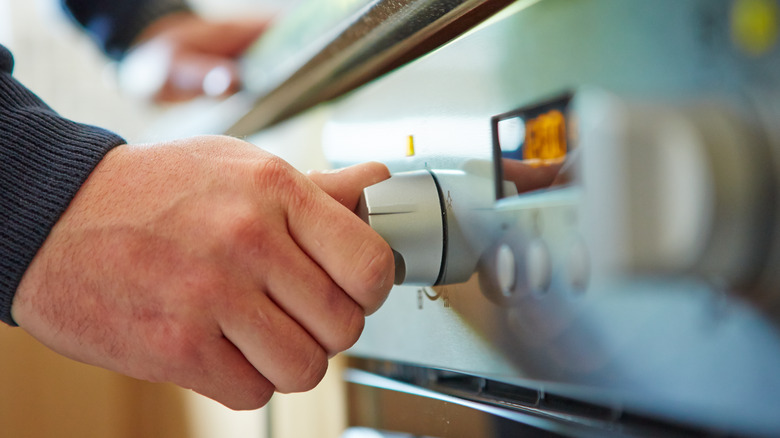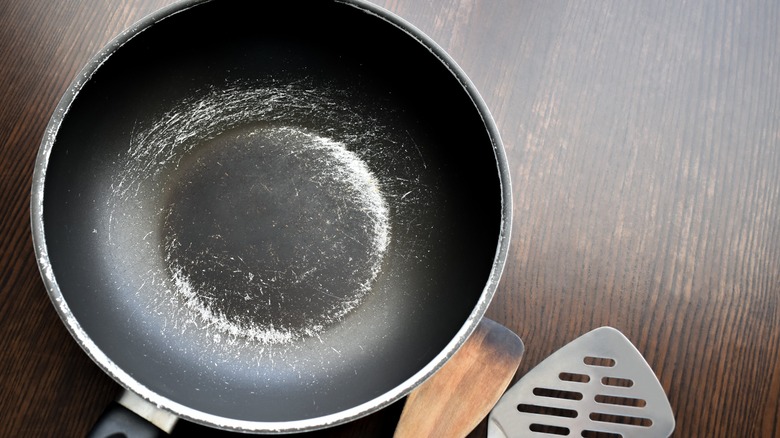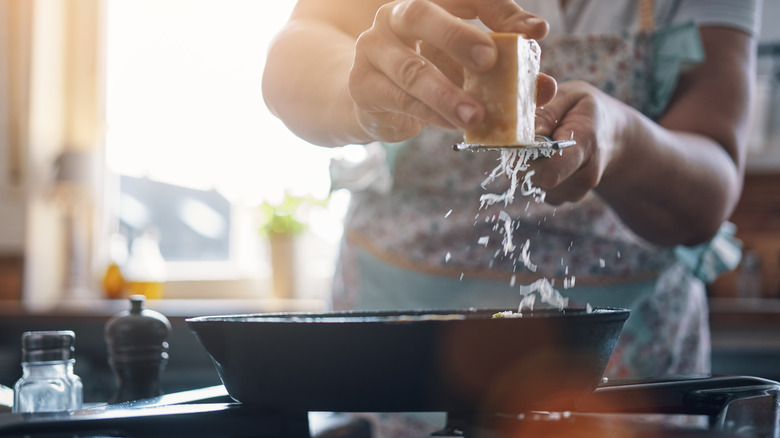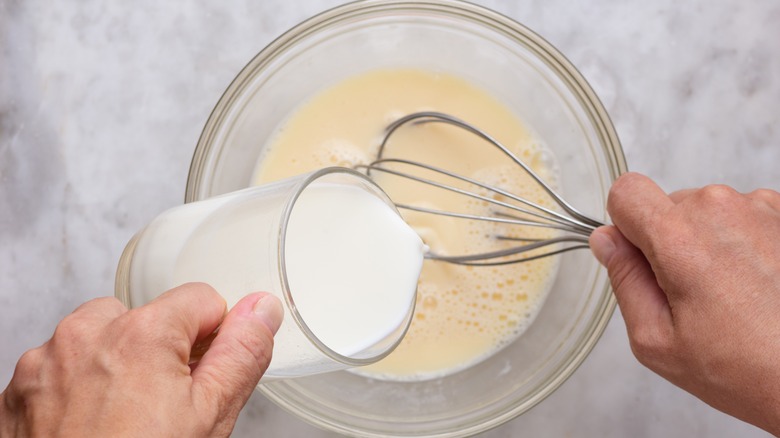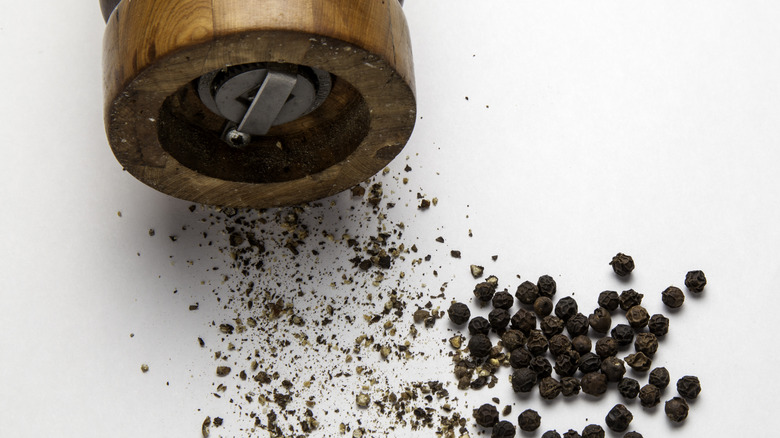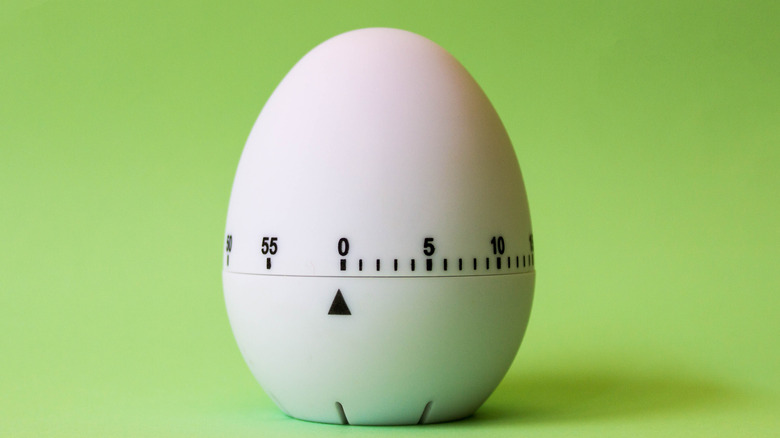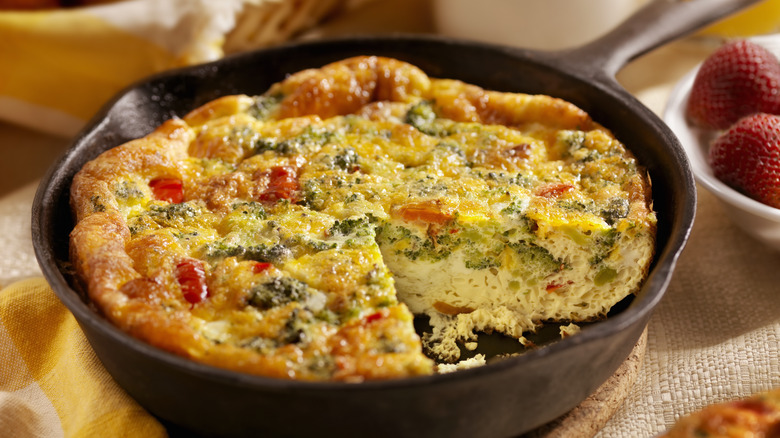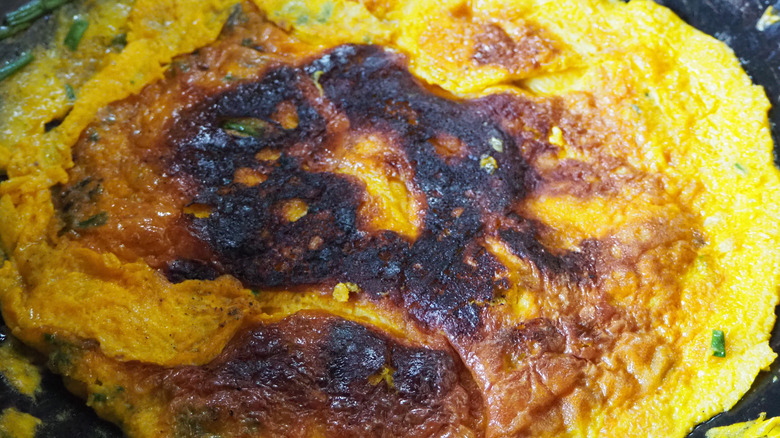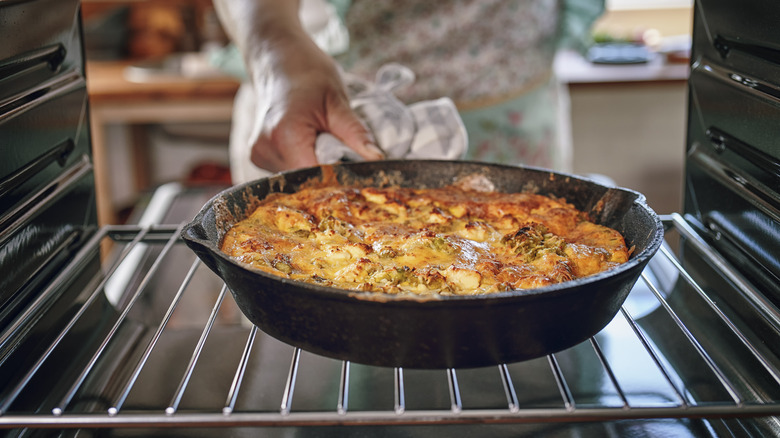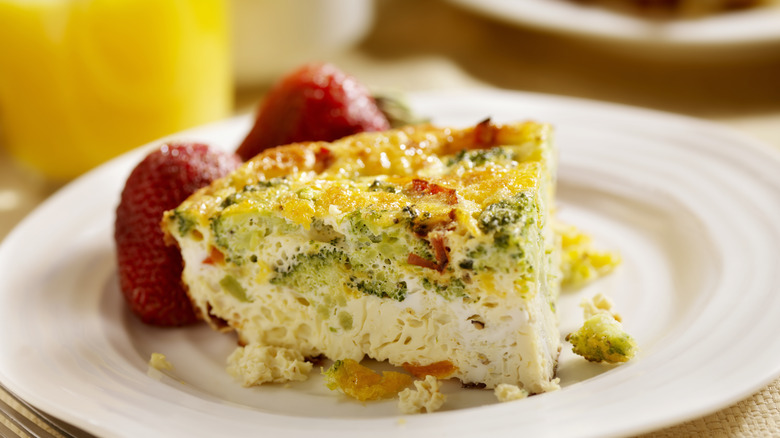Mistakes Everyone Makes When Cooking A Frittata
We all love eggs. And if you combine those eggs with some cheese, fresh herbs, a bit of dairy, and a selection of savory meats and cheeses and bake it all in the oven until ooey and gooey and golden brown, you get a frittata — quite possibly the world's most perfect meal!
Believed to have been dreamt up in Italy in the early 16th century, the word "frittata" comes from the Italian verb "friggere," which basically means "fried." Of course frittatas are delicious — they take all the foods we love and whip them together in a harmonious one-pot meal. But that's not the only reason we all crave them. They're also a super versatile dish — regardless of the ingredients, you can eat a frittata for breakfast, lunch, dinner or even a snack. They're also uber satisfying, like a light fluffy open-faced omelet. And perhaps best of all, for trained chefs and home cooks alike, they're also relatively easy to make. Just toss your ingredients together in an oven-proof skillet and bake to slightly creamy, custardy perfection.
But as classic and seemingly foolproof as the frittata might be, there are a handful of ways even the most experienced of cooks can turn a perfectly planned frittata into a bland, tough, or chewy "frit-aster." From the wrong pan to a lack of spices to too much liquid, here's a roundup of the biggest mistakes people make when cooking a frittata — plus some expert advice on how to avoid them!
Don't forget to preheat your oven when making a frittata
Ready to whip up a frittata? Don't let your creation get off on the wrong foot before you even start making it — be sure to turn your oven on and preheat it to around 350 degrees Fahrenheit before you start. Preheating the oven is an essential step when making a frittata — or just about anything else you put in the oven — because it helps to ensure that the food cooks evenly and thoroughly. If you don't preheat the oven, your dish will start cooking early as the oven is heating and parts of your food will be done earlier than other parts. But when you preheat the oven and then add your frittata, it will all cook in unison, creating that ideal fluffy and tender texture we all love.
For Ivan Beacco, owner of Red Inside Culinary Studio and a chef instructor with online cooking school Cozymeal, preheating is an essential part of the frittata-making process and a step that should never be skipped.
"It definitely makes a difference, he says. "Whenever you use your oven, there are very few instances where pre-heating isn't essential. It should always be a ground rule for baking anything."
Because frittatas need some initial frying for that crispy lower "crust," Beacco likes to start his on the stovetop and cook until partially set and then add them to the oven so the eggs can finish cooking at a consistent, slightly lower temperature.
Don't use the wrong pan
The typical recipe for making a frittata includes whisking your eggs together, adding in your extra meat and vegetable ingredients, pouring your mixture into an oven-safe skillet and then frying for a few minutes until the bottom of the frittata starts to set. You then add the entire skillet, eggs and all, into the oven to let it finish cooking.
But before you can do any of that, you need to select your pan! In general, the best frittata pan should match several key criteria:
- It should be oven-safe and can move from the stovetop to the oven without damage.
- It should have a flat bottom which allows the eggs to cook evenly.
- It should be the right size for the frittata you want to make — not too big or too small to fit in all your necessary ingredients.
According to Jennifer Segal, a classically trained chef and creator of the popular recipe blog and website Once Upon a Chef, poor pan selection is where a lot of people make the biggest blunders when making a frittata. They pick a pan that's too big and don't use enough ingredients to fill it, they go too small and overload it, or they pick a pan that can't go in the oven.
"You can use a non-stick pan, but you've gotta make sure it's ovenproof," she cautions. "And you've gotta be careful with nonstick pans — they can scratch. That's why cast iron is ideal."
Plan your frittata recipe in advance
The easiest option when it comes to making a frittata is to follow a recipe, and there are some great options out there. But unlike a cake or sauce, which might require more exacting ingredients and technique, a frittata is also a great place for even novice chefs to wing it.
In that case, however, Chef Beacco cautions that you should make sure to think through your recipe in advance. He also says that you should have your eggs and frittata filling ingredients prepped, measured out — what the French call mise en place — and ready to go, so you can be in the moment, making your frittata and watching it cook without scrambling to grab stuff you need.
Plan on "a couple eggs ... for each person," he advises, "plus one or two tablespoons of cream or milk and three or four tablespoons of cheese."
Pour this over your frittata filling mixture so everything is just covered and no "tops" from your ingredients are "sticking out."
"If they stick out, that means they're just too many [fillings] and they're not well distributed," he explains.
Spend a few minutes and measure out everything you need and then start cooking. When you have all your ingredients calculated, measured, and ready to go when you start cooking, it should not only lead to a better-tasting frittata but will also make the cooking process easier and more enjoyable as well, he says.
Don't overdo it with the dairy
One of the easiest ways to ruin a frittata, and one of the most common mistakes home cooks encounter when making them, is including too much extra moisture in the dish. Whether it comes from a heavy hand pouring in the milk or cream, or the unwanted moisture that cooks out of fresh ingredients like mushrooms, tomatoes, or zucchini (each of which has an incredibly high water content), too much water will destroy your frittata. It can leave the dish soggy, keep it from holding its shape, and may even prevent your eggs from firming up entirely.
To avoid falling into the "too much moisture" trap when prepping your next frittata, always completely drain any fresh ingredients before adding them to your pan. You can also press seemingly damp items like fresh produce between paper towels to absorb — and force out — some additional moisture. Or try an old-school chef trick and leave watery produce like mushrooms uncovered in your fridge for a day or two before cooking them, so they naturally dry out a bit!
Then, once you are sure your filling is relatively dry, keep the moisture you add to the frittata in check as well. Chef Segal says she likes heavy cream in her frittatas to make them come out more silky like an omelet. But she doesn't overdo it.
"More is not better," she cautions. "I use eight large eggs to ⅓ a cup of heavy cream."
Add plenty of spices — no one wants a bland frittata!
Salt and pepper, fresh herbs, and dried spices should all be considered and essential part of any good frittata recipe. After all, what's the point of baking up an incredible egg dish filled with incredible meats and vegetables if it's just going to end up tasting like nothing? And that's a mistake many home cooks make with frittatas — they don't add enough seasoning, they don't build flavor throughout the cooking process, and they just try to fix the lack of flavor at the end with some added salt and pepper ... which doesn't do much when your eggs are already cooked.
Don't make the same mistake! First, select a flavor profile for your dish. Are you going Italian, Latin, or Greek? Think about what flavors you can bring into your frittata, whether than means using spices such as paprika, garlic powder, or oregano. Or can you use fresh herbs instead? If so, their flavor is even more robust and will lead to an even better tasting frittata. Chives, basil, thyme, and parsley are all great considerations and work well in a variety of pairings.
"Eggs can be pretty bland," says Chef Segal. "I like to start my frittata by adding some shallots and garlic to my eggs. Then, with whatever vegetables you are adding to the mixture, you always want to season them too. You always want to season throughout the cooking process so that every element is favorable."
Be patient! Don't rush to cook your frittata
The length of time it takes to cook your frittata can vary depending on several factors such as the size of the pan you are using, the thickness of your frittata, and your oven temperature. A good rule of thumb is that you should cook your frittata on the stovetop for about 5 to 7 minutes, followed by an additional 10 to 15 minutes in the oven.
If you want the best-tasting frittata possible, don't rush the process, says Mark Farone, a chef and instructor with the acclaimed Cambridge School of Culinary Arts in Massachusetts. Slower cooked eggs are always better than fast-cooked eggs, he says.
"When I make scrambled eggs for myself, especially on a lazy Sunday morning, it takes me 20 minutes," Farone says. "I sit there and I baby them. I add the heat really gently over a really long period of time. The texture is completely different than trying to take something and rush through it in two minutes."
"How quickly you add heat into something, whether it's a steak or whether it's an egg — especially any kind of protein — is going to dramatically affect the texture," he adds. "So for frittata, if you start it on the stovetop until the bottom of the eggs set ... then finish it in the oven with a much more gentle heat [around 325 degrees Fahrenheit] to get you where you want to go, with a great texture."
Don't overcrowd the pan
Making a frittata, and figuring out how many ingredients you want to add is a bit like inviting Goldilocks over for a bowl of homemade porridge. You don't want to add too few and you definitely don't want to use too many: it's got to be just right.
And figuring that perfect ratio out can be tough, according to Farone, because based on fillings and ingredients, it changes with every frittata you make.
"You want your [egg-to-filling] ratio to be enough where you're not gonna have an architecture problem," he says. "If you jam too much in the pan, it's gonna have a hard time really binding. When you take the entire frittata out of the pan and cut it, [you don't want it] breaking into a hundred little pieces. It should still resemble a kind of 'egg pie.'"
His go-to strategy: try to fill up the pan with a lot of "loose" room around your filling, add just enough eggs to cover everything, then begin cooking. Also, importantly, don't go too crazy trying to combine too many different flavors or ingredients within a single frittata, Farone cautions. You don't want too many competing flavors, or too many ingredients that could let excess water out into your egg mixture and prevent it from cooking or setting up properly. Again, think Goldilocks. Not too little, not too much — it's got to be just right!
Avoid over- or under-cooking your eggs
"There's an old saying about eggs: done in the pan is dry on the plate," says Chef Farone. So how can home cooks best avoid over- or under-cooking their eggs?
"Just don't do that," he adds with a laugh. "I mean, it sounds silly, but when you're cooking one egg in a pan, it's pretty easy. The egg is right there. You can see it — is the white set? What is the yolk looking like? But when you put a dozen eggs in with a bunch of other stuff, it's harder to gauge."
So what does he do for a picture-perfect, well-cooked frittata?
"It depends on the diameter of the pan, but what I usually look for is a silver dollar-sized [spot] of almost — but not quite — set eggs right there at the center of the pan," Farone says.
When he sees that, he moves the frittata out of the oven, where it will finish cooking and the eggs will set up firmly.
People forget to take into account that food continues to cook when you remove it from the oven, he explains.
"The universe is always trying to balance itself out, so it says hey, the inside of me is cooler than the 350-degree [Fahrenheit] temperature, so I'm going to keep pushing heat inside as well. So the outside of your food continues to cook the inside of the food, and this is one of the biggest problems with egg cookery."
Always be sure to let your frittata rest
Your frittata is cooked perfectly. You've stuck a toothpick into the center and it comes out clean without any leftover egg residue. The only thing that's left to do now is dig in, right? Well hold up. Like a good broiled steak or a perfectly grilled pork chop, you need to let your frittata rest a bit before slicing in.
But there is a difference. Unlike those cuts of meat where resting helps the juices to redistribute, allowing your frittata to rest serves a different purpose. It helps the frittata to set and hold its shape, and it also allows the flavors to meld together and intensify.
Also, and very importantly, when you remove a frittata from the oven, it's still very hot and fragile. If you slice in to it immediately, the pieces may fall apart and the eggs may still be runny in the center, warns Beacco. Allowing the frittata to rest for around 5 to 10 minutes will give it time to finish cooking, and then cool down slightly so the eggs can fully set and you can slice it without your pieces falling apart.
"Besides, frittatas taste best when they are barely warm rather than piping hot," he says.
And Segal agrees, adding that for her, frittatas are best served at room temperature.
"They're a great dish to bring out at a picnic or to put out for a buffet brunch," she adds.
And the biggest frittata mistake of all? Not using leftovers in your recipe!
There are a lot of great combinations you can use when making your own frittata: spinach and feta, ham and cheese, mushroom and Swiss, smoked salmon and dill, asparagus and goat cheese — the list goes on and on!
But perhaps the biggest mistake anybody can make when making a frittata, according to Chef Farrone, is not using your frittata as a vehicle for leftovers, as they were originally intended by the Italians when the dish was first created way back when.
"You have to understand the magic of the frittata and the history of the dish to fully appreciate it," he says. "Frittatas are the perfect leftover vehicle. I grew up first-generation Irish and southern Italian, and my family would always make frittatas as a morning food. But the filling was the food that was leftover from the night before. You've got some leftover pasta or leftover potatoes or leftover vegetables — whatever it is, it goes in the pan. Then, when we had leftover frittata, we'd put that on salad like an egg crouton. And then if you have leftover salad from lunch, you would chop it up into fine little bits and you wrap it in a ravioli, right? And then the next morning, if you have leftover ravioli, it all starts again. It's the great circle of life and this beautiful way of using leftover food." Traditional and delicious — sign us up!
